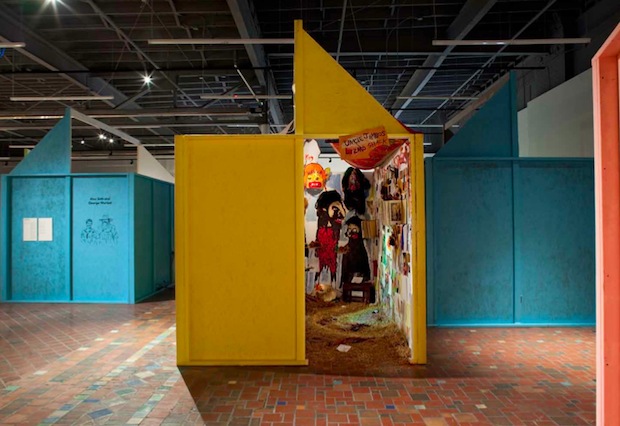
Cary Loren’s collaboration with Jimbo Easter at the “People’s Biennial” (Photograph by Corine Vermeulen, courtesy of the Museum of Contemporary Art Detroit and the artist.)
People’s Biennial
Museum of Contemporary Art Detroit
September 12, 2014 – January 4, 2015
4454 Woodward Ave, Detroit, MI
What’s on view: The large Woodward Street Gallery of the museum is filled with 17 painted plywood booths, each containing an installation borne of a collaboration between a noted artist and creative person from outside the art world. This is the second iteration of the People’s Biennial mounted by curators Harrell Fletcher and Jens Hoffmann. In the first, Fletcher and Hoffmann selected the “outsiders” themselves, but here, they have selected a group of established artists to, in turn, choose their own collaborators.
While the contrast between “inside” and “outside,” the “norm” and the “other,” and the institutional and the underrecognized is the crux of the People’s Biennial, “outsider art” hardly begins to cover the kinds of creative practices on display here. There are a few self-taught artisans and craftsmen featured who could comfortably fit into the typical “outsider art” designation, though a majority of others are simply highly-trained individuals from a variety of fields: designers, activists, intellectuals and social workers, as well as career artists who haven’t received commercial or institutional recognition.
Several installations read rather simply as mini, white-walled retrospectives of an overlooked practice, like Colter Jacobsen and Lance Rivers’ exhibit of Rivers’ expressive drawings of tunnels and bridges, or the collection of paraphernalia from Wendy Offerman’s career as a North Carolina-based, modern dance choreographer presented in collaboration with her daughter, artist Liz Magic Laser. Others temper the vision of the chosen collaborator through uninspiring art world M.O.s. MacArthur Fellow Rick Lowe manages to even package the work of Jonathan the Plant Man, a homeless person from Dallas, into insidery artwork; the Plant Man, a homeless person from Dallas who cultivates and then sells the plants he rescues from dumpsters, has made himself a staple of his community, though his originality and entrepreneurial spirit are impossible to see in this minimal installation of live plants that resembles a sparse gallery show of trendy plant art.

Paper mache man by Cary Loren and Jimbo Easter at the People’s Biennial, MoCAD (Image courtesy of Robin Dluzen)
Fortunately, outweighing the handful of duller collaborations are those that are fulfilling the curatorial mission of presenting powerful work that challenges what we’re accustomed to seeing in the museum. Detroit artist (and New York artworld favorite) Scott Reeder and Milwaukee-based cult figure Xav Leplae created a bizarre funhouse sound studio installation that is part exhibition, part interactive performance space, featuring incongruous objects (like handmade severed fingers, and an egg carton on which the phrase “Rabbi’s hard boiled eggs” has been scribbled) and a microphone encased in a knitted koozie that is transmitting the space’s sound on live radio. Cary Loren, a writer, artist, and founding member of Destroy All Monsters, collaborates with Jimbo Easter, a construction worker and self-taught artist and musician, resulting in a booth chock-full of nightmarish drawings, photographs, masks and hair, the floor covered with straw and the whole scene presided over by a rather creepy, full-size paper mache man. Easter’s aesthetic comes from of an admiration of Paul McCarthy’s work, though unlike McCarthy, Easter relies not on spectacle but an immersive experience that is deeply troubling in its freakishness, sincerity and intimacy. By far the most successful of the pieces in the People’s Biennial used this relatively open and unique opportunity to not only challenge what and who can be shown in the museum, but the way that work can be shown, instead of just translating work from the outside using the language of the inside.


Comments on this entry are closed.